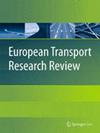公共交通系统吸引人的因素:对出行偏好和出行方式选择的回顾
IF 4.2
3区 工程技术
引用次数: 0
摘要
世界上许多地区都在努力实现从私家车到更可持续的交通方式的转变。虽然有许多关于旅行者偏好和出行方式选择的评论,但缺乏对公共交通系统具有吸引力的因素进行全面概述的最新评论。本综述旨在通过深入了解影响出行行为和公共交通需求的因素来填补知识空白。它有两个主要目标:•总结从国际文献综述得出的一般结论。•就有关北欧国家的主题提出具体见解。据我们所知,这是第一次以北欧为重点的关于公共交通偏好和出行方式选择的综述。特别关注这些国家的动机是,与许多其他国家相比,它们在减少运输部门排放方面的政策相对更为雄心勃勃,而且它们今天的公共交通使用率相对较高。方法为了达到这些目的,我们对现有文献进行了回顾。这篇综述包括国际文献综述,并包括对北欧国家结果的研究。调查结果显示,可靠性和频率是创造一个有吸引力的公共交通供应的重要因素。然而,关于这些属性的改善对公共交通需求的影响的证据有限,因此这需要更多的研究。这篇综述强调了了解出行方式选择的潜在动机的重要性,并就进一步研究公共交通供应吸引力的领域提出了建议。本文章由计算机程序翻译,如有差异,请以英文原文为准。
Factors that make public transport systems attractive: a review of travel preferences and travel mode choices
Abstract Background Many regions worldwide are struggling to create a mode shift from private cars to more sustainable transport modes. While there are many reviews regarding travellers’ preferences and travel mode choices, there is a lack of an updated review that provides a comprehensive overview of the factors that make public transport systems attractive. Aim This review aims to fill the knowledge gap by offering insights into the factors influencing travel behaviour and the demand for public transport. It has two primary objectives: • Summarize general conclusions drawn from international literature reviews. • Present specific insights on the topic pertaining to the Nordic countries. To the best of our knowledge, this is the first review with a Nordic focus regarding public transport preferences and travel mode choices. The special focus on these countries is motivated by their relatively more ambitious policies for reducing emissions in the transport sector compared to many other countries, and their relatively high usage of public transport today. Methods To achieve these objectives, we conducted a review of existing literature. This review encompassed international literature reviews and included an examination of results from the Nordic countries. Findings The findings show that reliability and frequency are important factors for creating an attractive public transport supply. However, there is only limited evidence regarding the impact of improvements in these attributes on public transport demand, so this needs more research. This review highlights the importance of understanding the underlying motivations for travel mode choice and provides recommendations on areas for further investigation to understand the attractiveness of public transport supply.
求助全文
通过发布文献求助,成功后即可免费获取论文全文。
去求助
来源期刊

European Transport Research Review
Engineering-Mechanical Engineering
CiteScore
9.70
自引率
4.70%
发文量
49
期刊介绍:
European Transport Research Review (ETRR) is a peer-reviewed open access journal publishing original high-quality scholarly research and developments in areas related to transportation science, technologies, policy and practice. Established in 2008 by the European Conference of Transport Research Institutes (ECTRI), the Journal provides researchers and practitioners around the world with an authoritative forum for the dissemination and critical discussion of new ideas and methodologies that originate in, or are of special interest to, the European transport research community. The journal is unique in its field, as it covers all modes of transport and addresses both the engineering and the social science perspective, offering a truly multidisciplinary platform for researchers, practitioners, engineers and policymakers. ETRR is aimed at a readership including researchers, practitioners in the design and operation of transportation systems, and policymakers at the international, national, regional and local levels.
 求助内容:
求助内容: 应助结果提醒方式:
应助结果提醒方式:


